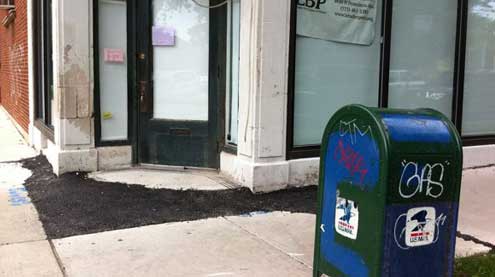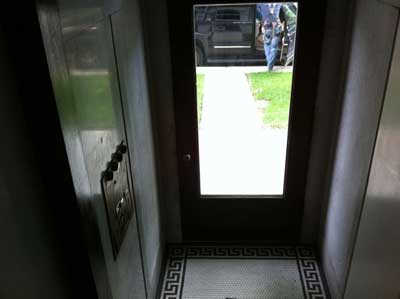Let’s say you grow up in an affluent, White suburb of Detroit (let’s not bother to pointe it out by name), yourself a nannied babe in the bad summer race riots right down the road of ’67. You’re weaned thereafter on some beast of fiscal/racial paranoia from your situation in that place of brutal contrasts between the haves and distinctly have-nots, in which you distinctly have and have lived right up and down one side of the very dichotomy, bumped up uncomfortably close to unfathomable neighbor next door, Detroit. Ensconced in green and boxy suburbs, you feel something like a weird egg and inevitably develop/inherit over the course of some years a complicated perspective on those blocks and blocks of dilapidated and burnt-out festering once magisterial houses where no one you know now lives– or, well, rather, yes, except for the maid.
So then you get the hell out– off you go away to a preppy, East Coast-scale affluent boarding school poised on a green and tended hilltop– away for a bit and back again, sort-of: to Michigan, nearby, an hour west and a world apart: thriving liberal college town Ann Arbor, fondly referred to in inaccurate geometric geekery as “A-squared”; then westward-ho! and la-di-da driving an American-made hatchback across the continent to pre-boom San Francisco with its succulents and steep dropoffs for a frolic with the software industry; down to the new-old South on a culinary/domestic Disney version of purgatory; up over rolly windy Grant Wood furrowed fields of Iowa for writing, porch-sitting, and getting square with the intellectual ego; and then, at last, into this other big and bigger, alive and kicking, steel-hard Midwest city…
Some days I’m appalled by my position of unrooted third floor ease, sit gazing backward, just spitting distance, really, just splitting the distance toward the old family ground– back there where a sister and a brother raise up families of an altogether other generation; where a desiccated and spindling matched set Mom and Dad trace vertical geologies up and down the staircases of that same prewar brick colonial, staking a claim despite age and rainwater cascading through the house’s porous foundation and down the basement wall.
I sit here just… something– amazed, appalled by the range of perspective contained in adjacent email messages– provoked into a fantasy of broken and resprouted urban acreage while reading this gorgeous GQ piece written by Howie Kahn (and including photos by the late Tim Hetherington) on the monumental demolition work in wasting, cancerous Detroit:
In 1950, with nearly 2 million people living within its boundaries, Detroit was the fifth-largest city in America. Over a forty-year period, the auto industry had boomed in a way that changed the country, and Detroit’s population more than sextupled. But starting in the ’50s, the city fell into decline. Factories closed. Jobs vanished. In the wake of the 1967 riots, race relations collapsed and the city became increasingly segregated. By 1980 the population had dwindled to 1.2 million. With far fewer Detroiters to shelter, many of the city’s houses were orphaned, threatening the existence and safety of everything around them. Blight metastasized across town, leaving much of the housing stock better suited for crackheads and squatters than for legitimate investors, possible gentrifiers, or working-class families with any remaining desire to stay. Today only 700,000 souls call Detroit home, and nearly a fourth of the city’s houses—a number approaching 72,000 units—are empty…
Wreckers in Detroit are like human Google Maps: They track all the physical changes—the torn-down houses, the fires, the new vacancies—practically in real time. They’ve also developed a finely tuned sense of protection that the city at large greatly lacks. Ask a wrecker here what he does and you won’t hear him talking about demolishing anything. When wreckers get talking, they talk primarily about making things safe.
“Before we can put a hole in a house,” explains Mike Farrow, owner of Farrow Demolition, “we have to make sure it’s clear. The city doesn’t clear it. If there’s squatters, dealers, crackheads in there, we’ve gotta get ’em out… One time I was clearing a house,” says Farrow, “and I got cut. The guy thought I was a cop. He was all doped up and slashed me with a knife.” Wreckers and inspectors enter these houses never knowing who or what lurks inside. They could be empty but could just as easily provide cover for the impulsively violent, the mentally unstable, or some solo junkie intent on protecting his daily ritual of dissolving into the ruins.
And then, just like that, with the abrupt unceremony of the whole digital media information delivery-receipt transaction, I find myself confronting a detailed description of the intensive workout routine of lean/mean and “tactical” “new Rahm” Emanuel as envisioned in the pages of Businessweek:
“I’ll give it to you if you are really that interested,†the 51-year-old mayor of Chicago says, sitting in a City Hall conference room one day in late June. “Monday, Wednesday, and Friday, I swim a mile in a 50-meter pool. I do a short chest exercise. Then I run two miles home. Tuesday and Thursday, I do 25 miles on the bike on random level 15, 15 minutes on the elliptical. You don’t want to know this, but I do 100 sit-ups, 50 push-ups, and a weight routine. Saturday, I bike 20 miles outdoors.†On Sundays, Emanuel attends a yoga class, to undo the side effects of his running and biking…
The stakes are immense. Emanuel’s success or failure could well determine whether Chicago remains a premier American city or suffers the kind of decline seen in Cleveland or even Detroit. If he can restore the city’s fiscal health with the participation of its workforce, he’d be able to portray himself as a new kind of Democrat able to work with labor unions to avoid mass layoffs, as New York Governor Andrew Cuomo did in June.
To my reading there’s a palpable implicit suggestion throughout this piece that a smart political operator in Emanuel’s shoes would beat a fast political course elsewhere.
There is, also, for me, an implicit and all-too-frequently encountered kneejerk disdain of these here “flyover states” in which we reside. Many the quick Californian I’ve “known” in one RL/digital arrangement and another who’s drawled that phrase before me like so much pocket lint. The same prejudice was present in elsewhere transplants to Iowa, onhand to partake of its famed writing milieu and accreditation gained away, dismissive of the daily pace and perspective of life beside a midwest river. There were as well those Westchester friends of boarding school days, the dyed in the wool New Yorkers, who queried closely and not at all ironically about the unimaginably savage lands westward, out in a mess of god-knows-what-all troubled with a pernicious lack of delis.
Here, for me, however, although brown-winter land littered with remnants of failed industry and Bunyanesque ferris wheel turned automobile tire, narrow expressway lanes past looming hulks of graffiti and char, is home.
I’m reminded again of just how marvelously and profoundly local reality is.
Since we returned from this summer’s grand adventure Up North, Chris has been kept busy with Downtown Civic concerns, minding the poor wounded Frankenthumb, which unswells and begins to show off its spiffy set of laces today to a city legal team bent on wrangling yet another labor union hairball.
Some days, the prospect of busting out strong-handled, sharpened implements, and rehabilitating a scourged plot of ground in New Detroit makes me feel weirdly optimistic and giddy, despite all traces of postapocalyptic gloom.
Here, today, refreshed by the recent change of scenery, I’m feeling around for moorings, taking snapshots of graffiti on neighborhood walks, shifting some pieces both psychic and physical that have needed rearranging or evaluation for scrap, and attempting to accomplish concrete somethings– fending off echoes of that “daily ritual of dissolving into the ruins”–shaking and ruffling my own distinct predisposition toward dereliction of a fluffy and bourgeois variety.
Today I feel I resorted somewhat to pilfering from notes composed to friends in, perhaps, more intimate arrangements of association, and transcribed here, a bit, into a wholly other arrangement of communication.
This action causes me to wonder yet again about the compulsion to communicate in this way as well as about the ever unknowable relationship between writer and ostensible reader here: an arrangement which bears the unique intimacy of thought inscribed in language and shared blind. These are, it feels to me and I suppose I hope, potentially potent and intimate experiences of writing, of reading.Â
For you, who are here in my imagination, I offer thanks and the invitation to write back and be read in turn.




